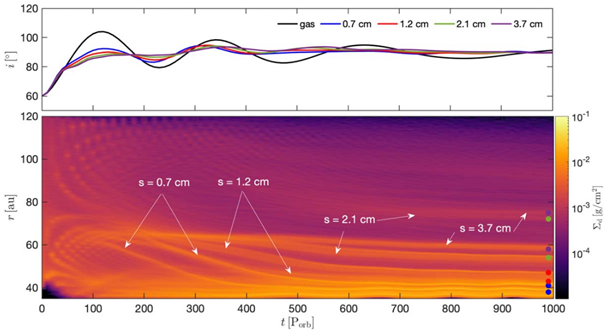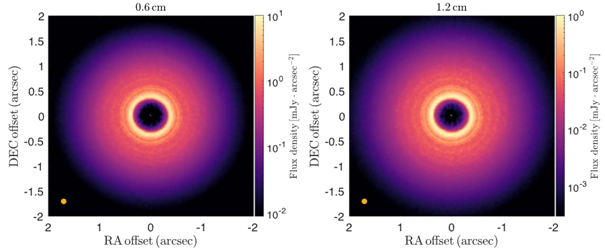Dust Traffic Jams Formed During Polar Alignment of Circumbinary Disks

In our galaxy, an estimated 40% of stars are members of binary systems, which are often embedded within a circumbinary dust disks. These disks often act as nurseries for young planetary systems, as dust inhomogeneities collapse in planetary bodies. As such the sizes, distributions and dynamics of these dust grains play a key role in understanding how these systems eventually come to be. That said, many of these disks have been found to be in misalignment with the orbital plane of the binary.
A recent study led by Jeremy Smallwood investigates an extreme example of this misalignment. Low-mass disks with strong misalignment will precess, eventually settling in polar alignment, orbiting perpendicular to the binary orbital plane. Smallwood et al explore this gradual precession, linking the process to the formation of dust traffic jams, which are believed to often be the sites of planetary formation. Such jams usually form in regions where there is differential precession between gas and dust components, making polar-aligning systems a likely candidate for the phenomenon.
The authors use a two-fluid hydrodynamical model to simulate components of gas and dust. In these simulations, dust grain sizes are treated as ranging from 0.7 to 3.7 cm. This range was chosen because the formation of dust traffic jams is expected to occur primarily at such large grain sizes. Their model was then evolved over the course of 67,000 years, forming dust jams at specific radii. The team subsequently used radiative transfer models to simulate continuum images of light passing through these dust clouds.

Historically, these are observed at millimetre wavelengths. This is the case for a multitude of reasons, but for one, simple optics tells us that shorter wavelengths are more resolvable, so we would like to minimise the observed waveband, while assuring we are still gathering worthy data. The study’s images show that the signatures indicative of dust traffic jams instead peak in the centimetre range. Current telescopes, such as those at the ALMA observatory, do not have the necessary resolution in this range to probe the dust. Instead, the team generates synthetic observational data by simulating measurements from upcoming facilities like the SKAO and ngVLA, which are expected to achieve the necessary spatial resolution at the appropriate wavelengths.

The study finds that the angular resolution of the upcoming SKA and ngVLA observatories should be enough to identify these dust traffic jams within circumbinary disks. They also suggest that future combined observations using the SKA, ngVLA and ALMA will help accurately probe the size and location of dust traffic jam, providing crucial insights into the dust grain growth process.
--
Journal Source: J. Smallwood et al, Observational Signatures of Dust Traffic Jams in Polar-aligning Circumbinary Disks, The Astrophysical Journal Letters, Vol. 976, No. 2, (2024), DOI: 10.3847/2041-8213/ad8faf
Cover Image Credit: University of Warwick/Mark Garlick
